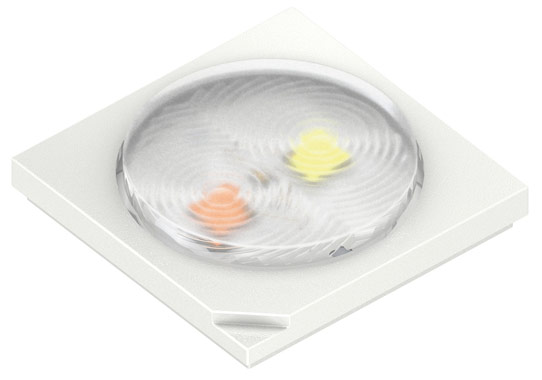- News
27 June 2017
Osram launches first multi-chip LED with lens integrated into single module, targeting camera flash applications
Osram Opto Semiconductors GmbH of Regensburg, Germany says that, for the first time, it has integrated two LED chips and a lens into a single module. The compact Oslux S 2.1 multi-chip LED gathers the firm’s technical expertise into a new LED product for camera flash applications. With its brightness of 125 lux, the Oslux S 2.1 provides uniform illumination of photos and video recordings from mobile devices such as smartphones.
Osram Opto’s new Oslux S 2.1 for camera flash applications combines two chips of different color temperatures - a cold-white chip of 6000K and a warm-white chip of 2250K (Dual-CCT) - providing both a multi-chip LED and a lens for the first time. This not only makes manufacturing easier by saving a step, but also produces excellent results, says the firm. With a maximum deviation of 300K, the Oslux offers high color fidelity and color uniformity across the target scene, it is claimed.

Picture: Osram Opto’s Oslux S 2.1 multi-chip LED.
The integration of two LED chips and a silicone lens in one module offers benefits in video lights and camera flash applications. Now, no separate step is necessary for optimum positioning of the lens, which saves time and optimizes the use of the generated light. While dimensions of 5.0mm x 5.0mm x 1.15mm make the Oslux S 2.1 with its lens slightly taller than previous models, it requires less space on the board and has a smaller exposed aperture than two single LEDs, making it more compact overall. The silicone lens also allows the module to be reflow solderable, allowing the module to be easily integrated into standard manufacturing flows.
“With the new Oslux S 2.1 we were able to achieve very high quality,” says product marketing manager Russell Willner. “We have subjected it to both electrical and optically demanding testing and are very happy with the results.”
The Oslux S 2.1 is available now, and in early 2018 Osram Opto is planning to release an additional version (Oslux S 2.2) with an epoxy lens (rather than a silicone lens). Due to this extremely hard material, the Oslux S 2.2 can be installed in mobile devices without a separate protective window, providing additional industrial design options. Also, a spectrum-optimized converter will provide the Oslux S 2.2 with better photos.


